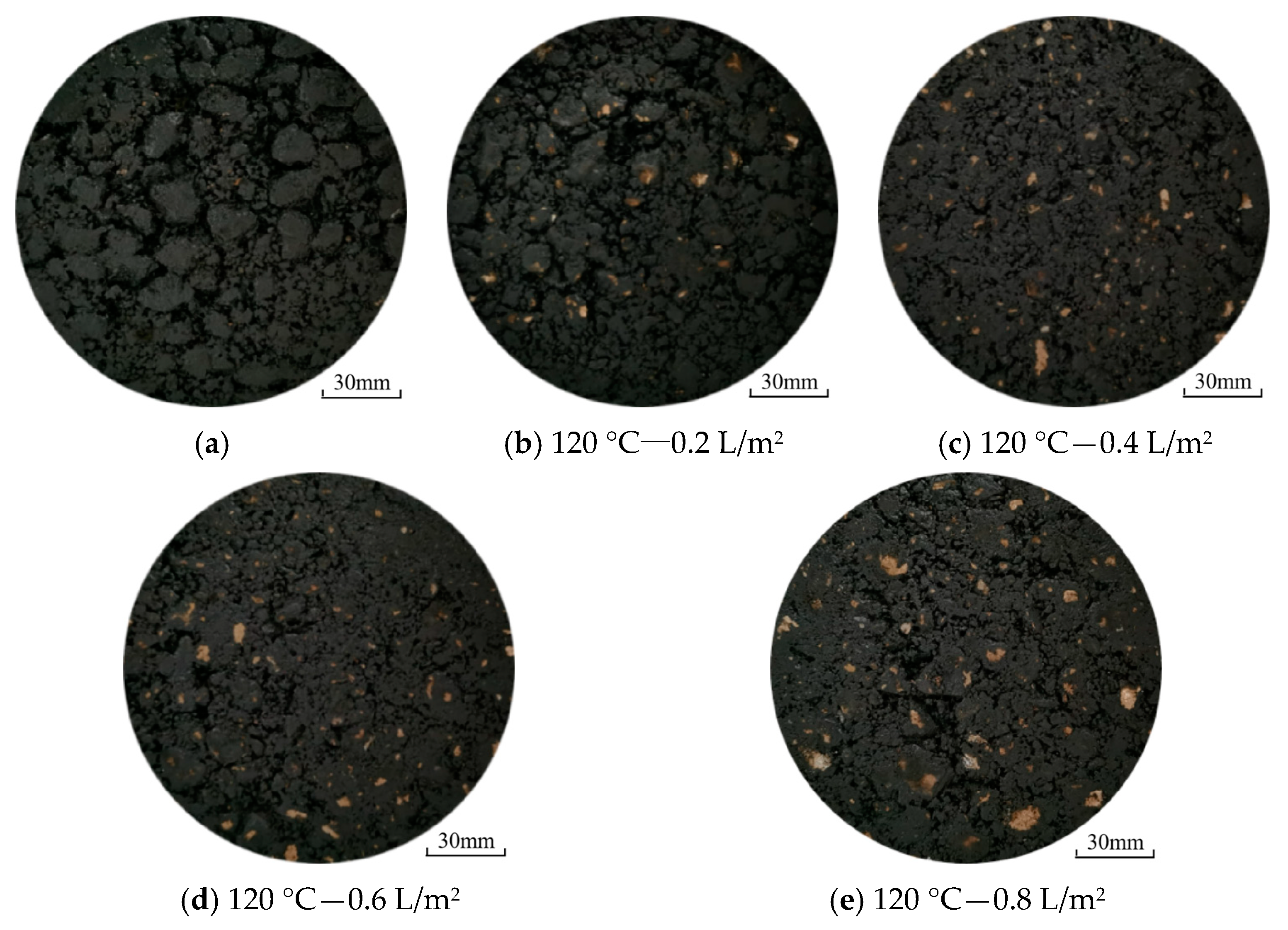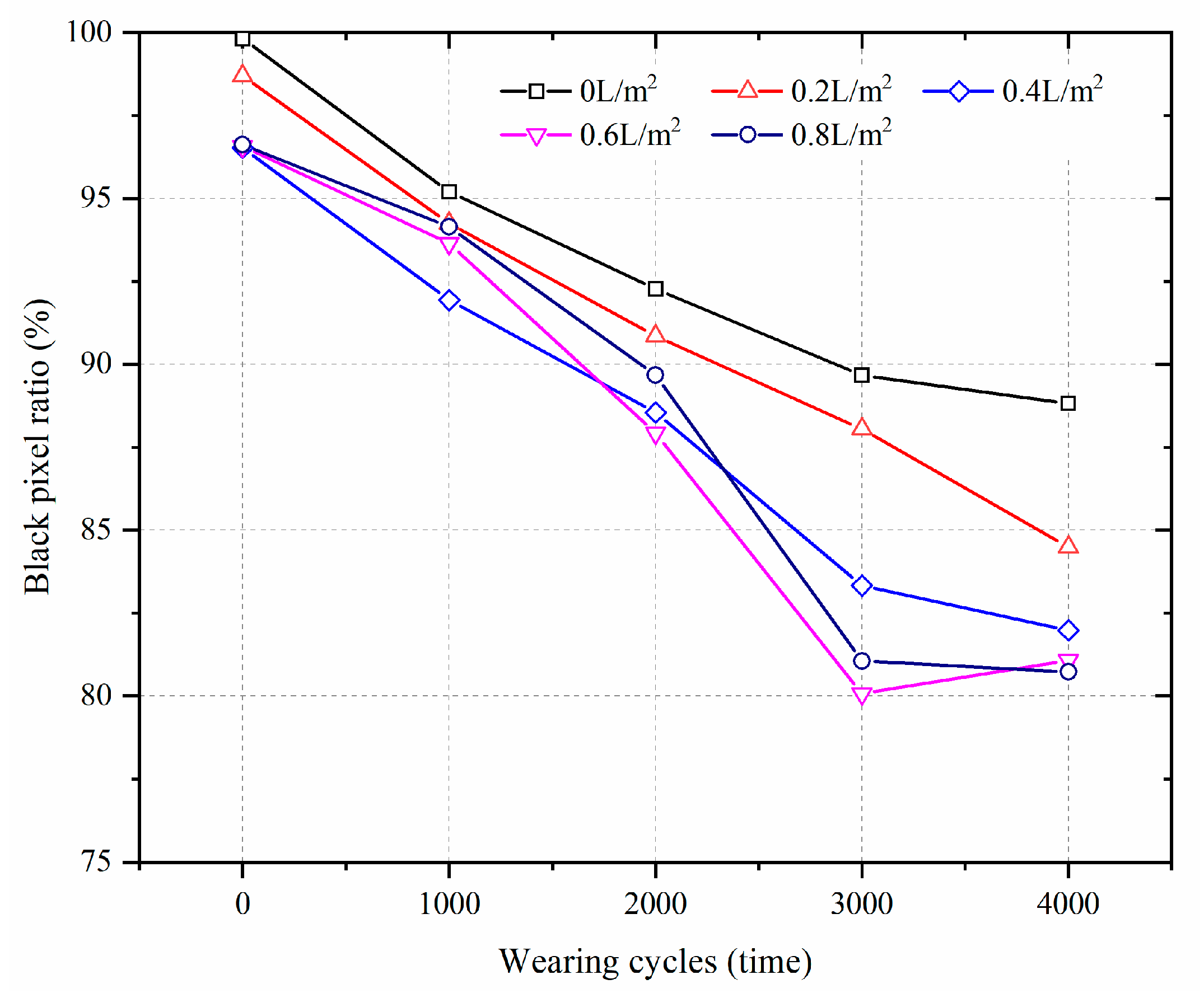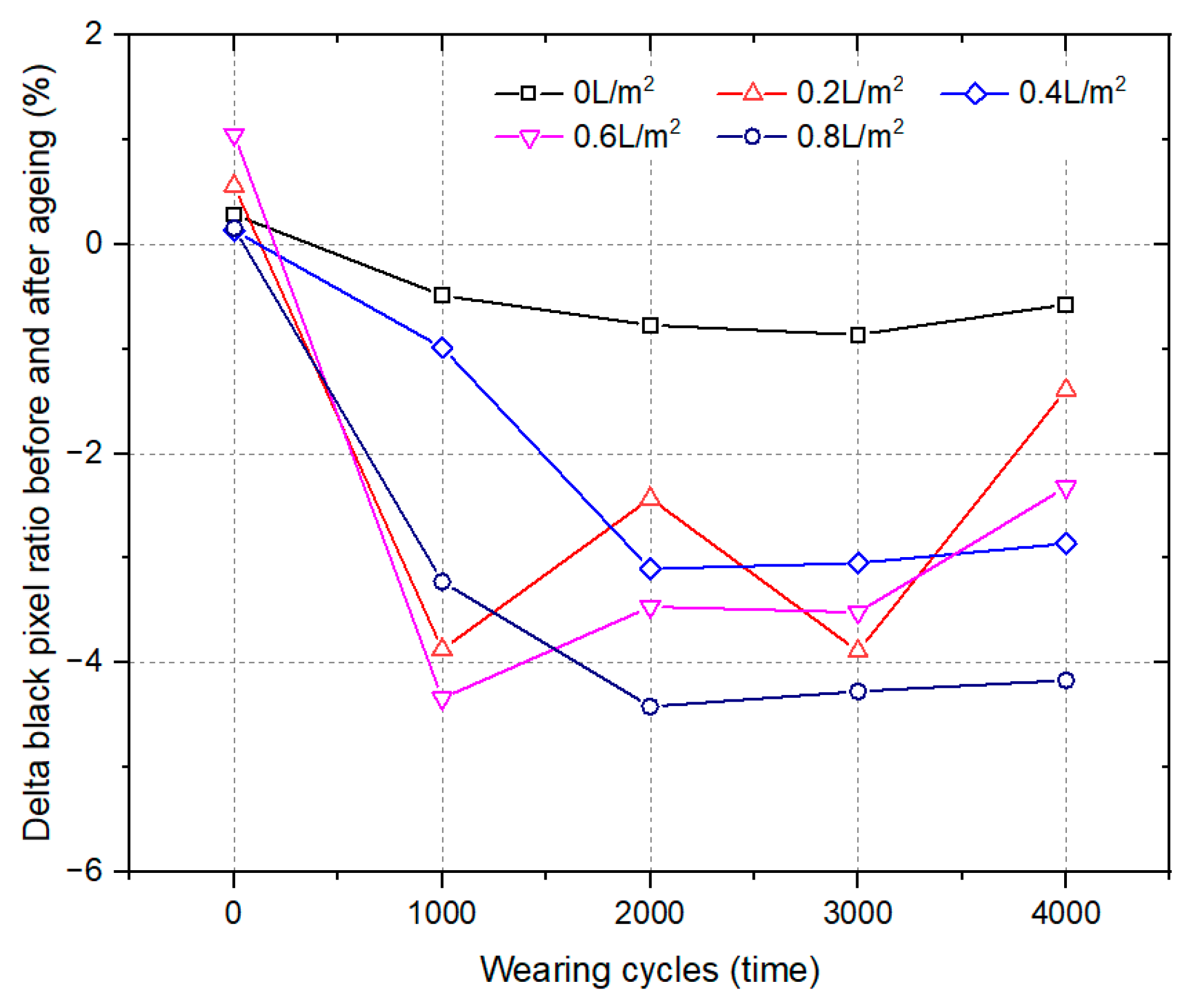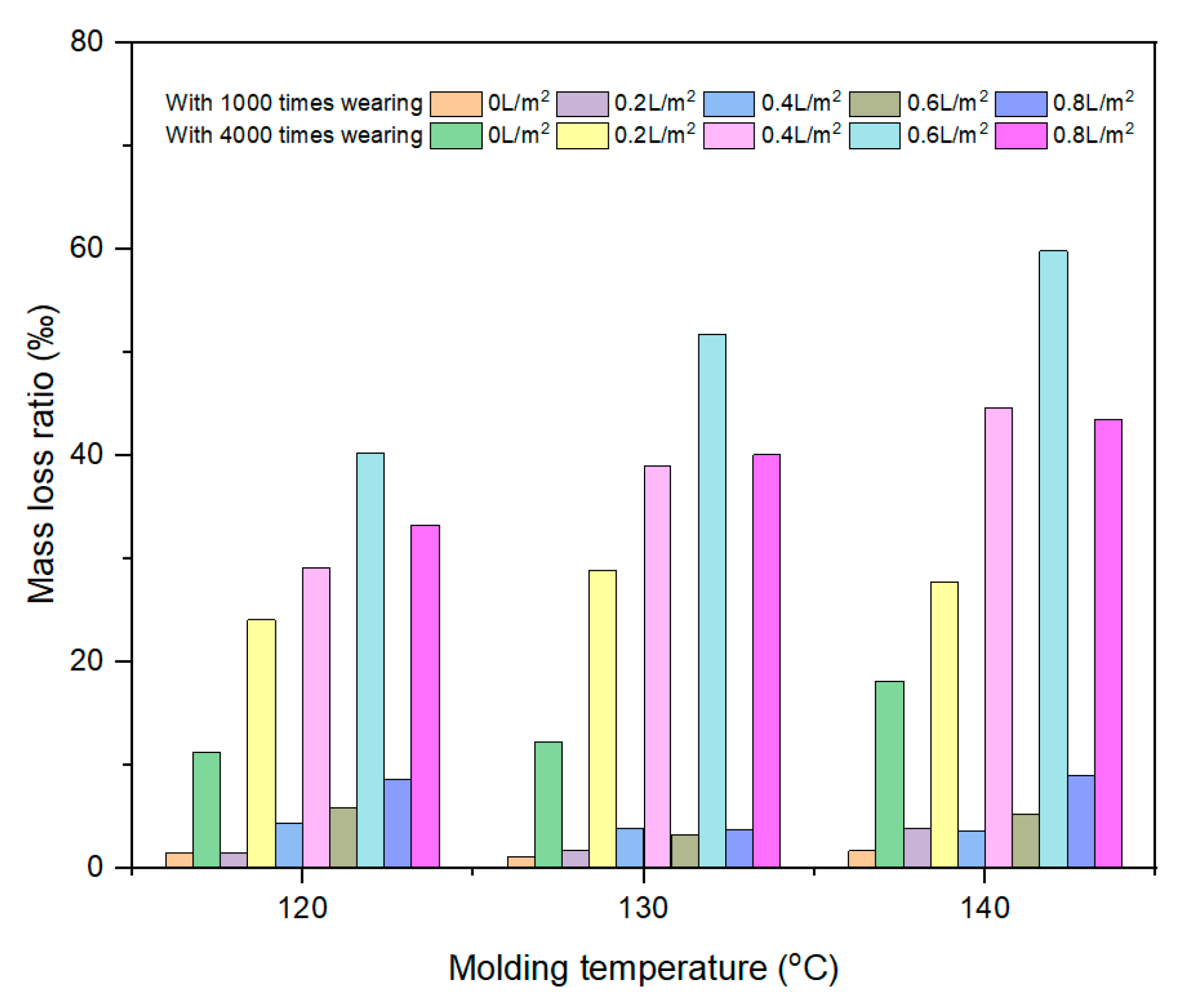The Effect of Water during the Compaction Process on Surface Characteristics of HMA Pavement
Abstract
1. Introduction
2. Materials and Methods
2.1. Materials
2.2. Sample Preparation and Test Procedure
2.3. Wet-Wheel Abrasion Test
2.4. Image Processing Method
2.5. Mass Loss Ratio
3. Results and Discussion
3.1. The Effect of Water on the Surface Polishing Characteristics of HMA
3.1.1. Water Consumption
3.1.2. Molding Temperature
3.1.3. Long-Term Aging
3.2. The Effect of Water on Surface Mass Loss of HMA
3.2.1. Water Consumption
3.2.2. Molding Temperature
3.2.3. Long-Term Aging
3.3. Correlation Analysis of Black Pixel Ratio and Mass Loss Ratio
4. Conclusions
Author Contributions
Funding
Institutional Review Board Statement
Informed Consent Statement
Data Availability Statement
Acknowledgments
Conflicts of Interest
References
- Zhang, H.L.; Chen, Z.H.; Zhu, C.Z.; Wei, C.W. An innovative and smart road construction material: Thermochromic asphalt binder. In New Materials in Civil Engineering; Butterworth-Heinemann: Oxford, UK, 2020; pp. 691–716. [Google Scholar]
- Xu, S.; Liu, X.; Tabaković, A.; Lin, P.; Zhang, Y.; Nahar, S.; Lommerts, B.J.; Schlangen, E. The role of rejuvenators in embedded damage healing for asphalt pavement. Mater. Des. 2021, 202, 109564. [Google Scholar]
- Jamal, M.; Giustozzi, F. Enhancing the asphalt binder’s performance against oxidative ageing and solar radiations by incorporating rubber from waste tyres. Constr. Build. Mater. 2022, 350, 128803. [Google Scholar]
- Guo, M.; Yin, X.; Du, X.L.; Tan, Y.Q. Effect of aging, testing temperature and relative humidity on adhesion between asphalt binder and mineral aggregate. Constr. Build. Mater. 2023, 363, 129775. [Google Scholar]
- Zhang, J.; Zhu, X.L.; Wang, W.S.; Chu, H. Experimental simulation for moisture damage of saturated asphalt mixture and evolution of mixture’s pore water pressure, accumulative strain. Constr. Build. Mater. 2023, 369, 130274. [Google Scholar] [CrossRef]
- JTG E20; Standard Test Methods of Bitumen and Bituminous Mixtures for Highway Engineering. Ministry of Transport of the People’s Republic of China: Beijing, China, 2011. (In Chinese)
- JTG F40; Technical Specifications for Construction of Highway Asphalt Pavements. Ministry of Transport of the People’s Republic of China: Beijing, China, 2004. (In Chinese)
- AASHTO M 323; Standard Specification for Superpave Volumetric Mix Design. American Association of State Highway and Transportation Officials: Washington, DC, USA, 2022.
- ASTM D3497-1979; Standard Test Method for Dynamic Modulus of Asphalt Mixtures. ASTM International: West Conshohocken, PA, USA, 2003.
- Research on skid resistance of asphalt pavement based on three-dimensional laser-scanning technology and pressure-sensitive film. Constr. Build. Mater. 2014, 69, 49–59. [CrossRef]
- Chen, S.Y.; Liu, X.Y.; Luo, H.Y.; Yu, J.M.; Chen, F.D.; Zhang, Y.; Ma, T.; Huang, X.M. A state-of-the-art review of asphalt pavement surface texture and its measurement techniques. J. Road Eng. 2022, 2, 156–180. [Google Scholar]
- Chen, X.H.; Steinauer, B.; Wang, D.W. Evolution of aggregate surface texture due to tyre-polishing. J. Cent. South Univ. Technol. 2011, 18, 259–265. [Google Scholar] [CrossRef]
- Zong, Y.J.; Xiong, R.; Wang, Z.B.; Zhang, B.; Tian, Y.G.; Sheng, Y.P.; Xie, C.; Wang, H.Y.; Yan, X.H. Effect of morphology characteristics on the polishing resistance of coarse aggregates on asphalt pavement. Constr. Build. Mater. 2022, 341, 127755. [Google Scholar]
- Fan, L.; Li, G.Y.; Chen, R.; Cao, L.W.; Meng, L.H.; Yang, J. The simulation and analysis on the roll influence factors and safety speed of vehicle under the extreme turning. In Proceedings of the 2015 International Conference on Fluid Power and Mechatronics (FPM), IEEE, Harbin, China, 5–7 August 2015. [Google Scholar]
- Wei, J.C.; Zhang, Z.C.; He, Y.L.; Tan, Q.W.; Yang, X.P.; Wang, D.W.; Oeser, M. Study on the Skid Resistance Deterioration Behavior of the SMA Pavement. Sustainability 2022, 14, 2864. [Google Scholar] [CrossRef]
- Kane, M.; Zhao, D.; Do, M.-T.; Chailleux, E.; De-Lalarrard, F. Exploring the Ageing Effect of Binder on Skid Resistance Evolution of Asphalt Pavement. Road Mater. Pavement Des. 2010, 11 (Suppl. S1), 543–557. [Google Scholar]
- Wang, H.N.; Wang, C.H.; Bu, Y.; You, Z.P.; Yang, X.; Oeser, M. Correlate aggregate angularity characteristics to the skid resistance of asphalt pavement based on image analysis technology. Constr. Build. Mater. 2020, 242, 118150. [Google Scholar]
- Xie, X.; Wang, D.; Liu, D.; Zhang, X.; Oeser, M. Investigation of synthetic, self-sharpening aggregates to develop skid-resistant asphalt road surfaces. Wear 2016, 348–349, 52–60. [Google Scholar]
- Liu, H.F.; Wang, Z.A.; Yang, C.X.; Chen, S.Y.; Yu, H.N.; Huang, T.; Li, X.L.; You, Z.P. Effect of Coarse Aggregate Characteristics on Skid Resistance Deterioration of the Ultrathin Wearing Course. J. Mater. Civ. Eng. 2021, 33, 04021051. [Google Scholar]
- Fang, Y. Study on the Mechanism of Color Generation and Decay of Asphalt Pavement. Master’s Thesis, Fuzhou University, Fuzhou, China, 2019. (In Chinese). [Google Scholar]
- Seo, Y.; El-Haggan, O.; King, M.; Lee, S.J.; Kim, Y.R. Air void models for the dynamic modulus, fatigue cracking, and rutting of asphalt concrete. J. Mater. Civ. Eng. 2007, 19, 874–883. [Google Scholar] [CrossRef]
- Liu, S.J.; Zhou, S.B.; Peng, A.H. Analysis of moisture susceptibility of foamed warm mix asphalt based on cohesion, adhesion, bond strength, and morphology. J. Clean. Prod. 2020, 277, 123334. [Google Scholar]
- Bairgi, K.B.; Mannan, A.U.; Tarefder, A.R. Influence of foaming on tribological and rheological characteristics of foamed asphalt. Constr. Build. Mater. 2019, 205, 186–195. [Google Scholar]
- Mohd Hasan, R.M.; You, Z.P.; Yang, X.; Heiden, A.P. Quantification of physicochemical properties, activation energy, and temperature susceptibility of foamed asphalt binders. Constr. Build. Mater. 2017, 153, 557–568. [Google Scholar]
- Xiao, S. The Study on Adhesion Ability of Asphalt to Aggregate and Methods to Improve the Wrater Stability of Asphalt Mixture. Master’s Thesis, Chongqing Jiaotong University, Chongqing, China, 2014. (In Chinese). [Google Scholar]
- Mieczkowski, P.; Budzinski, B. The influence of water on the heat loss of hot mix asphalt. Appl. Sci. 2019, 9, 1747. [Google Scholar] [CrossRef]
- Hainin, M.R.; Yusoff, N.I.M.; Satar, M.K.I.M.; Brown, E.R. The effect of lift thickness on permeability and the time available for compaction of hot mix asphalt pavement under tropical climate condition. Constr. Build. Mater. 2013, 48, 315–324. [Google Scholar]
- Gao, Y.; Huang, X.M.; Yu, W.B. The compaction characteristics of hot mixed asphalt mixtures. J. Wuhan Univ. Technol. Mater. Sci. Ed. 2014, 29, 956–959. [Google Scholar] [CrossRef]
- Omar, H.A.; Yusoff, N.I.M.; Mubaraki, M.; Ceylan, H. Effects of moisture damage on asphalt mixtures. J. Traffic Transp. Eng. Engl. Ed. 2020, 7, 600–628. [Google Scholar]










| Indexes | Unit | Specification Requirements | Testing Results |
|---|---|---|---|
| Penetration (25 °C, 100 g, 5 s) | 0.1 mm | 60–80 | 71 |
| Softening point | °C | >46 | 48.5 |
| Ductility (15 °C) | cm | >100 | 117 |
| Kinetic viscosity (60 °C) | Pa·s | ≥180 | 196 |
| Indexes | Unit | Specification Requirements | Testing Results |
|---|---|---|---|
| Bulk S.G. | N/A | N/A | 2.715 |
| Apparent S.G. | N/A | ≥2.6 | 2.846 |
| Water absorption | % | ≤2 | 1.15 |
| Crushing value | % | ≤26 | 13.1 |
| Los Angeles abrasion | % | ≤28 | 117 |
| Indexes | Unit | Specification Requirements | Testing Results |
|---|---|---|---|
| Apparent S.G. | N/A | ≥2.5 | 2.672 |
| Mud content | % | ≤3.0 | 2.5 |
| Sand equivalent | % | ≥60 | 68 |
| Angularity | s | ≥30 | 39 |
| Indexes | Unit | Specification Requirements | Testing Results | |
|---|---|---|---|---|
| Apparent S.G. | N/A | ≥2.5 | 2.795 | |
| Passing percentage | 0.6 mm | % | 100 | 100 |
| 0.15 mm | 90–100 | 90.4 | ||
| 0.075 mm | 75–100 | 78.6 | ||
| Hydrophilic coefficient | N/A | <1 | 0.74 | |
| Plasticity index | % | <4 | 3.4 | |
Disclaimer/Publisher’s Note: The statements, opinions and data contained in all publications are solely those of the individual author(s) and contributor(s) and not of MDPI and/or the editor(s). MDPI and/or the editor(s) disclaim responsibility for any injury to people or property resulting from any ideas, methods, instructions or products referred to in the content. |
© 2024 by the authors. Licensee MDPI, Basel, Switzerland. This article is an open access article distributed under the terms and conditions of the Creative Commons Attribution (CC BY) license (https://creativecommons.org/licenses/by/4.0/).
Share and Cite
Dai, B.; Mao, L.; Pan, P.; Hu, X.; Wang, N. The Effect of Water during the Compaction Process on Surface Characteristics of HMA Pavement. Materials 2024, 17, 2146. https://doi.org/10.3390/ma17092146
Dai B, Mao L, Pan P, Hu X, Wang N. The Effect of Water during the Compaction Process on Surface Characteristics of HMA Pavement. Materials. 2024; 17(9):2146. https://doi.org/10.3390/ma17092146
Chicago/Turabian StyleDai, Bingquan, Lei Mao, Pan Pan, Xiaodi Hu, and Ning Wang. 2024. "The Effect of Water during the Compaction Process on Surface Characteristics of HMA Pavement" Materials 17, no. 9: 2146. https://doi.org/10.3390/ma17092146
APA StyleDai, B., Mao, L., Pan, P., Hu, X., & Wang, N. (2024). The Effect of Water during the Compaction Process on Surface Characteristics of HMA Pavement. Materials, 17(9), 2146. https://doi.org/10.3390/ma17092146







